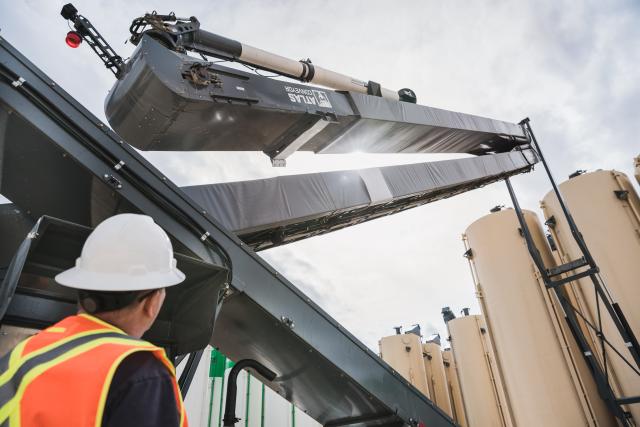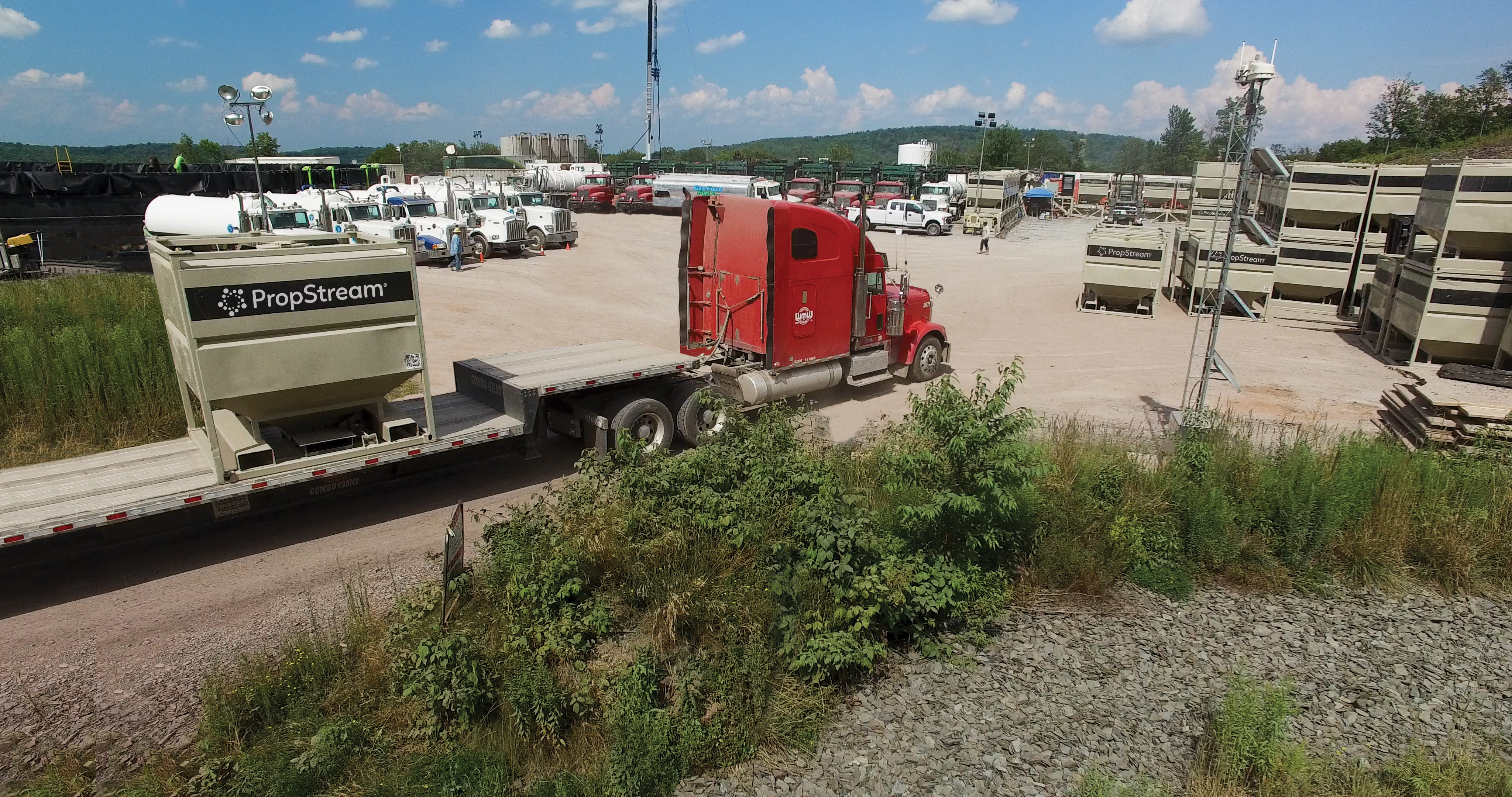
A top-fill conveyor system prepares to load a six-pack silo system with more than 3 MMlb of proppant. (Source: Hi-Crush)
Managing costs and meeting the growing demands of hydraulic fracturing depends on a complex proppant supply chain that reaches from the mine to the blender. By the time it is pumped downhole, frac sand has been selectively mined and processed, moved in massive volumes to the basin or mined there and ultimately delivered to the blender at the well site.
Directly managing the complexities and urgencies of wellsite operations presents a unique and demanding challenge. Time-critical, cost-sensitive and with a dynamic array of variables, last-mile sand logistics have evolved with a diverse and highly specialized system of equipment, software and expertise.
High-impact sand
Proppant logistics must reliably and efficiently orchestrate many moving parts from the mine to the blender.
First is delivering huge volumes of frac sand to the well site. Growing activity and greater sand intensity have made this challenge increasingly acute. Frac designs have grown to 500,000 lb of proppant per stage or more, and a single frac crew may pump more than 48 MMlb per month.
More than 50% of operators surveyed by Infill Thinking viewed trucking and logistics as the major chokepoint and cost driver in 2018. This year only 11% of respondents voiced that concern, indicating that new, innovative solutions from companies focused on last-mile technology and expertise have countered the current complexities of frac sand logistics.
But sand volume is only part of the proppant logistics challenge. Variables range widely from customer design modifications to the weather. Road and wellsite conditions must be known, and traffic congestion must be considered, all while managing demurrage costs and driver reliability issues. Safety concerns run the gamut from noise to regulated emission of silica sand dust.
Intensified challenge
Last-mile proppant logistics begin at a transload facility or in-basin mine. In-basin mines improve local sand availability and eliminate rail transportation costs. The first in-basin mine in the Permian Basin, developed by Hi-Crush, began operations in July 2017 to provide a close-proximity resource for rapidly growing activity and volume intensity in West Texas and New Mexico.
These advantages are quickly complicated by considerations that may affect decisions about how to optimize volumes and rates. Many in-basin mines are farther from the well site than strategically located transload facilities that would serve the same work. While the average one-way distance from a transload facility to the well site is roughly 96 km (60 miles), the mine may be closer to 145 km (90 miles).
Logistics are further complicated in managing efficient loading and timely dispatch of hundreds of sand trucks. Transport on highways and roads must deal with less than ideal infrastructure, road repairs, accidents, weather, tight turns and weight limits. Simple delays can have significant repercussions at the well site.
At the well site, proppant logistics face congestion caused by the many sand, chemical and water trucks entering and exiting the location. Entry, offloading and exit must be closely coordinated for optimum offload speed and safety on an already busy and crowded well site, frequently with poor cellphone service hampering communication.
The complexities have spurred the development of a broad set of web-based and mobile app software capabilities. Used by operators, service companies, sand suppliers and others, the advances include real-time technology that provides an important tool for vendor, product and driver management, with greater visibility for data including turn times, driver performance, terminal congestion and demurrage.
Software management capabilities range from equipment tracking and geo-fencing to inventory and load reconciliation. Sand stage and consumption reports also are being generated by proppant logistics software, and future capabilities may include wellsite management tools such as radio frequency identification container scanning, silo integration with trucking data, order automation and invoicing.
Silos and containers
The industry has largely adopted two multicomponent last-mile delivery methods centered on silo- and container-based systems. Vertical silos store large volumes of proppant with a minimal onsite footprint. They support multiwell and large-volume, high-rate frac treatments. Container systems transport and store sand on site in portable bins. They provide a highly flexible option for smaller frac jobs and where roads and wellsite size present constraints.
However, determining the optimal last-mile solution is a more complex, nuanced logistical undertaking than the two options suggest. Often the decision depends on an expert process that weighs many factors. Hi-Crush’s PropStream service integrates these options to tailor proppant logistics services to specific wellsite logistical and operational conditions and objectives.

Sorting out the options
Silo and container systems each present unique capabilities and advantages for proppant logistics. Key to their initial development was addressing the time and safety constraints of traditional pneumatic methods.
Comparatively, silos and containers unload sand much faster and reduce wellsite congestion with dramatic cuts in time spent on location. Container systems can deliver and stage full bins and pick up empty ones in less than 10 minutes on site. Silo systems using hopper-bottom trucks and gravity-fed conveyor systems may require less than 15 minutes for unloading and transiting the location. Pneumatic systems can take more than an hour to do the job.
Container systems, and silo systems with advanced top-fill technology, greatly mitigate silica dust emissions and personnel exposure by implementing engineering controls. Current Occupational Safety and Health Administration permissible exposure limits regulations restrict exposure to 50 micrograms of respirable crystalline silica per cubic meter of air, averaged over an eight-hour day.
Gravity-fed conveyor technology used by silo and container systems minimizes dust creation and exposure with covered conveyors and enclosed transfer points. These purpose-built systems are an advance over pneumatic systems that blow sand with pressurized air, cutting silica emissions by more than 90%.
Silo and container systems each have unique logistical advantages to consider and balance in selecting the optimal solution.
Silo systems provide a vertical storage solution for up to 280 tons of proppant per silo, making it the most efficient storage system relative to wellsite footprint. Individual silos are transported to the well site and safely raised to a vertical position using specialized erector trailers. Setup time for some six-pack silo configurations can be as little as two hours.
Alternatively, container systems transport proppant in one or two containers per truck for loads up to 25 tons. Containers quickly are staged on site to store frac sand until needed. Up to five containers at a time can be loaded onto an enclosed blender conveyer system during a job.
However, what appears to be a relatively clear-cut logistics decision is a bit more complicated. For example, containers require less time to offload and have a flexible, minimal footprint, while hopper-bottom trucks have larger loads but require more time to unload. In addition, the use of hopper-bottom trucks requires silos that can be top-loaded from enclosed conveyor systems. Because they eliminate pneumatics, these systems also significantly reduce silica dust emissions.
Truck weight, local road restrictions and time of year also figure in the equation.
In the Marcellus, containers systems are an advantage on the typically narrower, winding roads and smaller pads, compared to the Permian Basin where larger well sites and longer, flatter roads often make silo systems more attractive. Load limits and frost regulations in the northern Bakken region may seasonally cut vehicle weight versus the Permian Basin, eliminating the potential advantage of silos and higher capacity hopper-bottom trucks.
The many variables of last-mile proppant logistics often make the relative advantages of silo and container systems a moving target. The optimal solution requires a careful assessment considering specific wellsite and geographic conditions, safety requirements and operator objectives.
Conclusion
The evolution of last-mile proppant logistics has fielded an array of specialized equipment systems. Guided by expert logistics management and sophisticated software, silo and container technologies provide flexible, adaptable tools for optimizing completion efficiency.
Recommended Reading
Santos’ Pikka Phase 1 in Alaska to Deliver First Oil by 2026
2024-04-18 - Australia's Santos expects first oil to flow from the 80,000 bbl/d Pikka Phase 1 project in Alaska by 2026, diversifying Santos' portfolio and reducing geographic concentration risk.
Iraq to Seek Bids for Oil, Gas Contracts April 27
2024-04-18 - Iraq will auction 30 new oil and gas projects in two licensing rounds distributed across the country.
Vår Energi Hits Oil with Ringhorne North
2024-04-17 - Vår Energi’s North Sea discovery de-risks drilling prospects in the area and could be tied back to Balder area infrastructure.
Tethys Oil Releases March Production Results
2024-04-17 - Tethys Oil said the official selling price of its Oman Export Blend oil was $78.75/bbl.
Exxon Mobil Guyana Awards Two Contracts for its Whiptail Project
2024-04-16 - Exxon Mobil Guyana awarded Strohm and TechnipFMC with contracts for its Whiptail Project located offshore in Guyana’s Stabroek Block.




